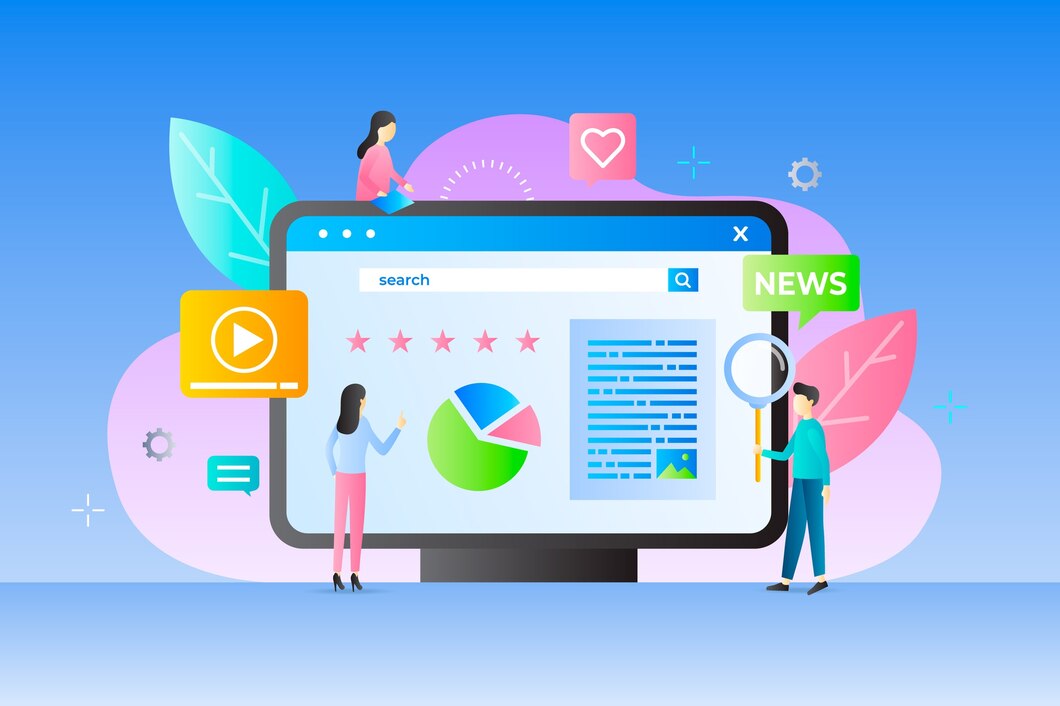
Out of billions of people who make resolutions at the beginning of every year, approximately 9 percent achieve their goals. Most people set goals that they unconsciously believe are unattainable. Some of the Social media marketing agencies fall in the same category because their marketing strategies are too broad and impractical. You should implement proper social media plan driven by data to make crucial decisions if you want to succeed in social media marketing.
It is not a rocket science! If you focus on these six simple points, you can instantly improve the performance of your social media campaign and achieve results beyond what you have expected.
What Is Data-Driven Marketing?
The world of marketing has evolved from the process of assumptions and guesswork to launching a campaign. This evolution is the result of the discovery of a dynamic tool. Now, the marketers turn to the most reliable data for strategizing marketing campaigns, customer data. This marketing approach is now called data-driven marketing.
In other words, the approach of data-driven marketing uses customer information to optimize brand communication. The marketers use customer data to predict their requirements, shopping behavior, and desires. Data-driven marketing ensures personalized marketing strategies for the customer. This results in a high return on investment.
Why Do You Need Data-Driven Social Media Marketing?
Social media marketing is using hashtags, using GIFs, and posting compelling copies. But, to earn the desired ROI from social media marketing we have to dig deep. Data-driven social media marketing comes to the rescue here. The presumption about a data-driven approach to social media marketing is time-consuming.
Well, social media marketing without using customer information is like shooting arrows in the dark. You will end up wasting time and resources. This will also affect your brand image as you will not deliver the products your customers want.
This is why you need a data-driven approach to social media marketing. With the right data set, you will target the right audience, know what they want, and deliver accordingly. It can tell you what’s working and what’s not working with your social media strategy. Hence, without wasting time and resources you provide what your audience wants. Data-driven social media marketing allows marketers to connect with the customer with the apt offerings at the right time. The technologically advancing world also plays its part in supporting data-driven culture. The furiously changing trends are necessary to keep up with and, customer data is the only rescue.
Hence, reducing the chances of making social media marketing strategies with assumptions and allowing for running successful campaigns.
How To Create A Data-Driven Culture?
The traditional research methods of survey focus groups and interviews cannot work alone for data-driven marketing plans. So, you need to gather every information possible. This data will help you build an effective marketing strategy. The key to activating and understanding your target audience is listening to them. The following tips will help you create a data-driven culture. They will also help you to optimize your brand’s image:
- Be attentive to your audience’s wishes: Begin with paying attention to your audience’s conversation on the internet. These conversations can take place, on different social media platforms. Analyze the conversations to know what the audience wants from your brand. It will bring you across the expectation of your audience. You might discover problems faced by them, and also their wishes about the product.
For example: Let’s say your audience is food lovers. With their conversations online, you can discover what keeps them connected and the factors that set them apart.
- Ensure covering all the relevant channels: Listening to your target audience on social media is always rewarding. But, just social media is not enough. You can listen to your brand interaction on Quora, Twitter, blogs, news or podcasts. The conversations on different channels give you deep insight into audience wishes. Keep an eye on every little mention of your brand.
- Capture the audience’s insight in real-time: Data-driven marketing is based on timely updates on the audience’s wishes. It is significant to stay up-to-date with the conversation and follow them in real-time. If delayed customers might move to other brands. The rapidly changing nature of trends requires real-time updates in the marketing strategy. Hence, staying updated also saves the brand from a last-minute crisis.
1. Set SMART goals
The funds spend on social media are expected to double from 2014’s $7.52 billion to $17.34 billion in 2019. The only way you can make a mark on the social media marketing industry is by creating measurable and time-sensitive goals. By doing this, you will not only have more traffic to your website, but you will also track your business growth. As a social media manager, you stand a lower chance of fulfilling your clients’ expectations if you do not make data-driven social media goals. The following is an outlined procedure on setting clear attainable and measurable social media goals in just four steps:
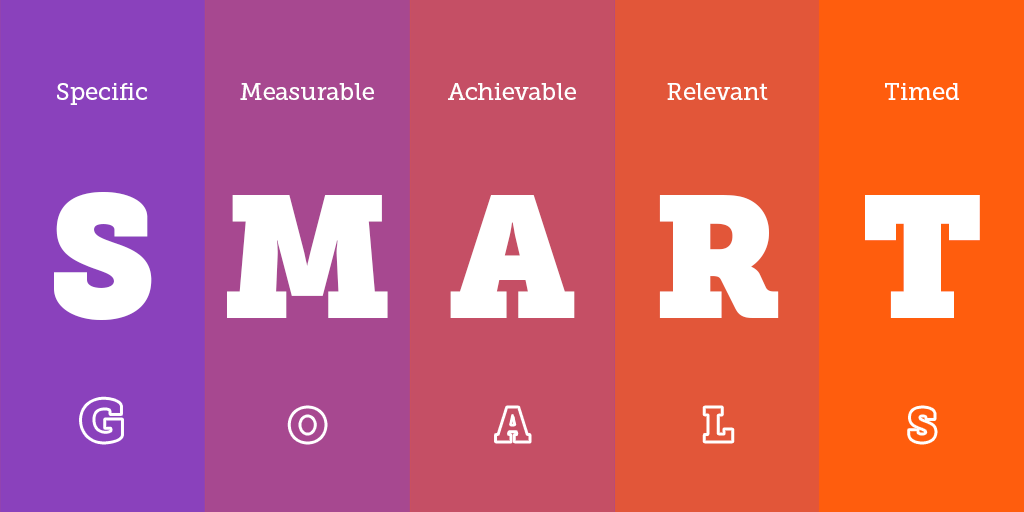 Source: https://blog.weekdone.com/smart-goals/
Source: https://blog.weekdone.com/smart-goals/
- Create specific, measurable, achievable, realistic and time sensitive goals (SMART): For the goals to be specific, they must be clear and straight to the point. A measurable goal is one that has metrics which can be analyzed. The realistic element of a goal shows whether the goal is achievable in the set time and available resources or not. Lastly, for any goal to produce relevant results, it must have a time-frame. Other strategies for creating goals include vision-based and growth-based techniques that can be customized to produce desired results.
- Identify your goal metrics: Several social media metrics are very effective depending on your goals such as the intriguing metric method. This method involves measuring the high, low traffic and conversion to find the biggest opportunities for growth.
- Audit your social media profiles: To be able to track your growth and if your strategy is working, you need to know in what state you were. By doing this, you make it easier to analyze the current metrics.
- Review your efforts towards goal vs targeting: This is a very crucial step if you want to succeed in social media marketing which most businesses ignore. Receiving and reviewing feedback gives you the assurance of achieving the set goals on time.
2. Which social media platform is best for you?
Once your brand or product is up and running, you will need to put in more effort to get the word out there. Unfortunately, it is a cumbersome task to accomplish because it requires making well-informed decisions based on dynamic data trends of social media platforms. Over 69 percent of Americans are using at least one social media platform to share information, learn or for entertainment. This begs the question, which platform is best for marketing your business?

Source: PewInternet.org
Here I recommend selecting social media platform by considering various factors listed below:
- Type of Business (B2B or B2C) – If your business is only targeting B2B audiences, Linkedin is the best platform to connect with fellow business owner. For B2C, other social media platform can give better result as compare to Linkedin.
- Target Demographic – You should start with the social media platform where you can find your prospect easily. Lets for example, if your product is for women only, you should start with Pinterest. The reason is very obvious, out of all adults who use social media in US, 38% of women are using Pinterest as compare to 15% of Men.
- Target Location – You should choose social media platform by considering the popularity in specific location. Lets for example, If your target location is Chine, non of those popular social media platform will work for you as in China, WeChat is the most popular social media platform and you should start with it.
Apart from this, you can also consider the type of content (text, visual, data), micro data like interest, age, revenue, job profile etc to choose the most suitable social media platform to start with. Here is the data associated with each social media platform that will help you to choose the one for your brand.
#1. Facebook has the largest number of users with 3.5 billion as of the third quarter of 2021. With around 2.9 billion monthly active users. If you plan on marketing your product and services to the age group between 18-29 years, Facebook is the right platform with 88 percent of them. Also, Facebook has the highest number of users over 60 years. Many insurance companies and pension funds take advantage of it.
Suitable content: Visual content with detailed text post will perform best at Facebook
#2. Twitter is very popular social media platform with over 317 Millions active users. If you are targeting US audiences, 21% of total social media users based there are on Twitter. If your product or brand is targeting both male & female audiences, Twitter can be the best platform for you.
Suitable content: Small and catchy tagline along with image / gif / video can perform best at Twitter. You can use twitter to connect with you industry influencer who may advocate your brand or services.
#3. Pinterest is dominated by brands that market female-oriented products and services. These may include fashion, food, books and home decor. Out of all women visiting social media sites, 42 percent are Pinterest users, therefore, making it easier for brands in these niches to market themselves.
L’Oreal Paris is the best example of how brands are using Pinterest:

Instagram has half a billion users and is the most targeted platform for creating a brand awareness campaign by posting beautiful photos and videos. However, bear in mind that you cannot include links to a website along with your posts, hence it is a challenge to use this platform for marketing. Instagram is the best platform for branding and visual content can do the magic. Nowadays, various eCommerce brands are effectively utilizing this platform to generate sales though various methods discussed here.
Based on these social media statistics, you can choose the best platform for your business depending on your target market and growth rate.
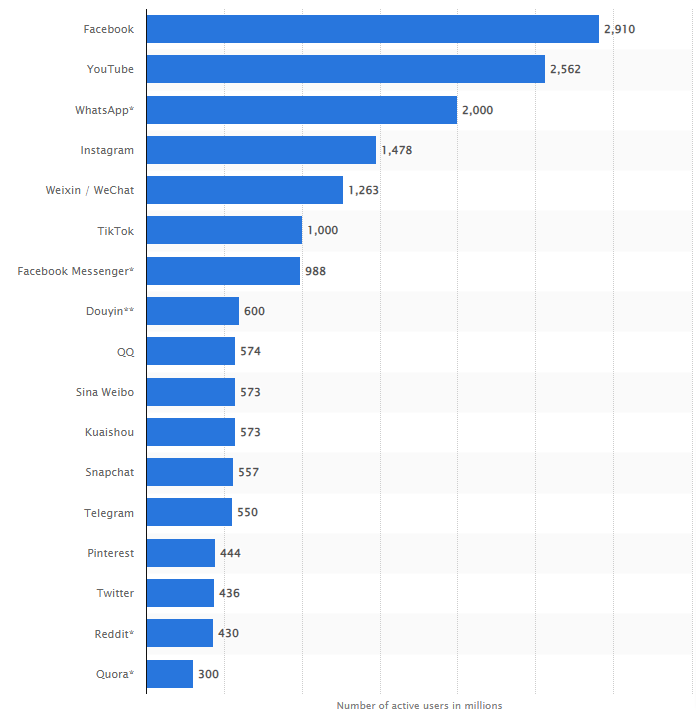
Source: statista
3. Get content production right
There are several creative Ad types in the market each for a specific audience. Communicating accurate information to the right audience is what makes an Ad campaign successful. For example, a brand awareness campaign is most effective when the content not only entices the users to click on it but also provides more information about the brand. The content must be remarkable and compelling to attract the user’s attention. Many businesses are globally recognized because of an effective brand awareness campaign such as the App engagement ads on Facebook shown below.

On the other hand, App installs involve showcasing the app’s primary purpose and vision to get new users to sign up. I have tested the App install ad for one of our in house application and here is the result:

You can see that the cost per install is just $30 and we received around 41 downloads withing small time frame. The number can be increase by considering your target countries and the type of app.
If you are new to content production for social media, the best method is to study your competitor’s campaign and review engagement. This will give you best idea on which content is performing better and test the same with your audiences. Other options include Offer Claim ads, website conversions, Clicks to website and event ads which you can take advantage of depending on the content and your target audience.
Don’t hesitate to take help of tools available online, they will provide you best insight about popular social media content and will do your job easier. Looks like BuzzSumo analyzes content which works well in the industry, therefore, giving an insight into the social footprint of the business. You can search content by category and study its social shares which gives you great input on planning your next content strategy.
4. Timing, Timing, Timing
Every social media platform has low, medium and high peak hours where you can publish content. Despite the 1.28 billion daily active users on Facebook, getting your desired organic reach needs a tactful approach. Wednesday through Sunday are the most recommended days to post, Thursday being the best. It is now wise to post your content during the wee hours because they are the least optimal posting times. According to the statistics, ensure you keep the posts short and clear. Videos are far more useful with or without sound on Facebook.
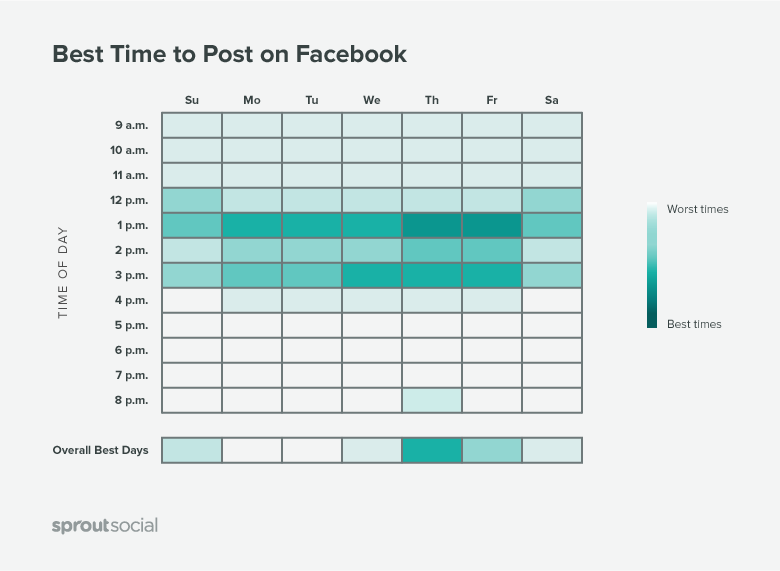
Source: SproutSocial
Twitter is a leading giant which businesses use to communicate with their customers. Therefore, the best days to post are Monday through Thursday between noon and 3 pm. Always follow some of the key leaders in your industry and avoid posting in the wee hours.
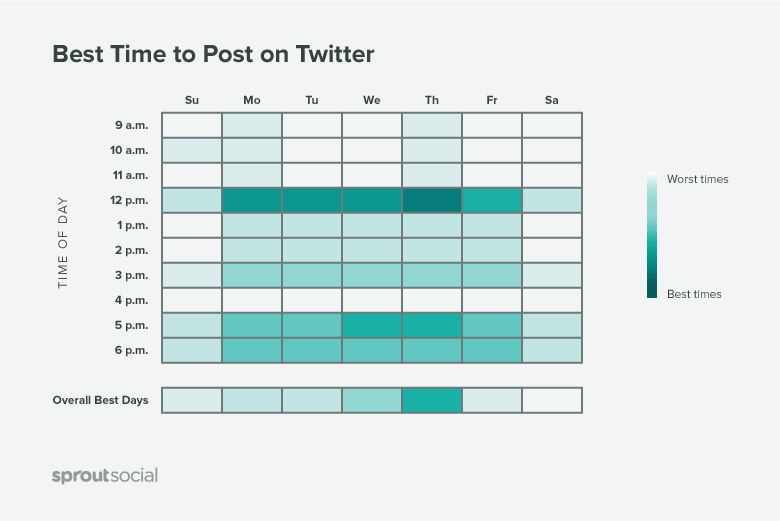
Source: SproutSocial
Having the highest per-follower interaction rate of 2 percent, Instagram has the most number of users joining daily. Here, the more enticing you make your post with colors, emojis, etc., the more clicks you get. Monday through Friday are the best days to publish content with Monday leading in stats. 2 am, 8 am and 5 pm are the most optimal times to post.
Others like LinkedIn, Pinterest, Google+ follow similar patterns to Facebook and Twitter.
Fortunately, you don’t have to keep tracking the times to post because there are a variety of tools used to schedule posts. You can choose the one according to your requirement that helps manage all your social media profiles at a go and schedule posts.
5. Be feedback friendly to track the right metrics
Tracking the right metrics helps monitor the progress of your social media marketing strategy. The following metrics are tracked:
- Growth of followers
- Posting schedule – Comparison between posts published on different time of the day & different day of the week.
- Likes, reactions to post, comments & replies
- Tags
- Audience demographics
- Organic reach
- How much content is shared
- Use Google analytics to obtain referral traffic data
- Examine click rates
Keep your eye on these metrics and consider them while working on next content strategy for your social media campaign. Over a time, you will see the huge improvement in performance that can result in better ROI. If you serve the right content to the right audience, you will definitely see the improvement in these data. Here you need to focus on who is your target audience and accordingly serve the ads for better engagement.
6. Don’t get lazy [Be consistent]
Consistency is an essential element for a successful social media campaign. However, you need to take care of self-promotion on the platform. Using the scheduling tools mentioned above, the promotional messages on your profile should not be too many too often. At what ratios are you posting and how consistent are you in keeping optimal times? If done right, these two elements of a post can have a very high number of engagements. Post engagement works like an immediate word of mouth and brings in more likes.
Benefits Of Data-Driven Social Media Marketing Strategy
You cannot imagine the magic of data-driven social media marketing. The social media growth strategy with a data-driven approach can most benefit the brand. The benefits of a data-driven social media marketing strategy are as follows:
● Identifying the target audience for your brand: The primary aim to launch a social media marketing campaign is to reach your target audience. The data-driven approach helps you identify your target audience, which is your potential customer base.
● Finding the right social media platform to target them: The presence of an audience on different social media platforms differs with age. For example, the young age audience between 12-and 20 years of age will be found mostly on Snapchat, while the older audience above 40 years of age is on Facebook. Hence, the data-driven approach lets you know the presence of a target audience on different social media platforms.
● Improving the social media campaign strategy: There might be cases when a social media marketing campaign doesn’t work for your audience. With data-driven marketing plans, you can know the reasons for failure. You can also analyze the wishes of your audience before planning your next marketing campaign.
● Analyzing and benchmarking against your competition: The data-driven marketing lets you analyze your competitor’s performance. This helps you in competition benchmarking and ultimately improves your marketing strategy.
The best part of data-driven social media marketing is that it is not that complicated. With the help of tools and the right marketing strategy, you are ready to collect the data. The tools also help in the impactful presentation of the data for making better decisions.
Cool Tools To Track And Measure Social Media
We all know about the miracles of data-driven social media marketing. With the cherry on the cake, we bring to you some specific tools to track and measure your social media. These tools would make your campaign analysis a cakewalk. Let’s look at these cool tools:
- Google Analytics: Most loved tool among marketers, Google Analytics helps you decide on the conversion points for your brand. These conversion points can be different social media platforms, websites or search engines. Later, you can analyze the conversion rates from each conversion point.
- Mention: This tool helps you with competitive benchmarking. Using the tool you can see your and, your competitor’s brand mentions across social media channels. You can calculate brand reach and also judge the influencer mentions of your brand.
- Bitly One View: It gives insights into your content performance across channels. You can track the incoming traffic on your post. You can also compare the organic and paid traffic.
- The Brand Grader: It is a free tool that shows your brand image across the internet. It shows factors like brand mentions, influencer mentions, geographical distribution, and social following.
Conclusion
More business owners and entrepreneurs are getting familiar with the concept of social media marketing as the years go by. Therefore, it is important to gather as much information as you can that will make your business thrive in the industry.
Finally, conducting in-depth research on social media strategies for other companies in your industry will ease the transition. The success of your business depends solely on getting the word out there about your products. Implement these strategies for your business and experience an increased ROI.
Contact Form Popup
Boost Your Business Now
This will close in 0 seconds
apply now popup
Apply Now
This will close in 0 seconds
Get free audit popup
Get Free Google Ads Account Audit Worth $999
This will close in 0 seconds

